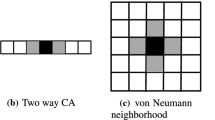Abstract
We investigate cellular automata as acceptors for formal languages. In particular, we consider real-time one-way cellular automata (\(\text{OCA}\)) with the additional property that during a computation any cell of the \(\text{OCA}\) has the ability to dissolve itself, so-called shrinking one-way cellular automata (\(\text{SOCA}\)). It turns out that real-time \(\text{SOCA}\) are more powerful than real-time \(\text{OCA}\), since they can accept certain linear-time \(\text{OCA}\) languages. On the other hand, linear-time \(\text{OCA}\) are more powerful than real-time \(\text{SOCA}\), which is witnessed even by a unary language. Additionally, a construction is provided that enables real-time \(\text{SOCA}\) to accept the reversal of real-time iterative array languages. Finally, restricted real-time \(\text{SOCA}\) are investigated. We distinguish two limitations for the dissolving of cells. One restriction is to bound the total number of cells that are allowed to dissolve by some function. In this case, an infinite strict hierarchy of language classes is obtained. The second restriction is inspired by an approach to limit the amount of nondeterminism in \(\text{OCA}\). Compared with the first restriction, the total number of cells that may dissolve is still unbounded, but the number of time steps at which a cell may dissolve is bounded. The possibility to dissolve is allowed only in the first k time steps, where \(k\ge 0\) is some constant. For this mode of operation an infinite, tight, and strict hierarchy of language classes is obtained as well.







Similar content being viewed by others
References
Buchholz T, Klein A, Kutrib M (2002) On interacting automata with limited nondeterminism. Fundam Inform 52:15–38
Buchholz T, Kutrib M (1997) Some relations between massively parallel arrays. Parallel Comput 23:1643–1662
Buchholz T, Kutrib M (1998) On time computability of functions in one-way cellular automata. Acta Inform 35:329–352
Cole SN (1969) Real-time computation by \(n\)-dimensional iterative arrays of finite-state machines. IEEE Trans Comput C–18:349–365
Dyer CR (1980) One-way bounded cellular automata. Inform Control 44:261–281
Fischer PC (1965) Generation of primes by a one-dimensional real-time iterative array. J ACM 12:388–394
Fischer PC, Kintala CMR (1979) Real-time computations with restricted nondeterminism. Math Syst Theory 12:219–231
Harao M, Noguchi S (1975) Fault tolerant cellular automata. J Comput Syst Sci 11:171–185
Ibarra OH, Kim SM, Moran S (1985) Sequential machine characterizations of trellis and cellular automata and applications. SIAM J Comput 14:426–447
Ibarra OH, Palis MA (1985) Some results concerning linear iterative (systolic) arrays. J Parallel Distrib Comput 2:182–218
Kintala CMR (1977) Computations with a restricted number of nondeterministic steps. Ph.D. thesis, Pennsylvania State University
Klein A, Kutrib M (2003) Fast one-way cellular automata. Theor Comput Sci 295:233–250
Klein A, Kutrib M (2007) Cellular devices and unary languages. Fundam Inform 78:343–368
Kutrib M (2008) Cellular automata—a computational point of view. In: Bel-Enguix G, Jiménez-López MD, Martin-Vide C (eds) New developments in formal languages and applications, chapter 6. Springer, Berlin, pp 183–227
Kutrib M (2009) Cellular automata and language theory. In: Meyers RA (ed) Encyclopedia of complexity and system science. Springer, New york, pp 800–823
Kutrib M (2012) Non-deterministic cellular automata and languages. Int J Gen Syst 41:555–568
Kutrib M, Löwe JT (2003) Space- and time-bounded nondeterminism for cellular automata. Fundam Inform 58:273–293
Mazoyer J, Terrier V (1999) Signals in one-dimensional cellular automata. Theor Comput Sci 217:53–80
Nakamura K (1999) Real-time language recognition by one-way and two-way cellular automata. In: Mathematical foundations of computer science (MFCS 1999), LNCS, vol 1672. Springer, pp 220–230
Nishio H, Kobuchi Y (1975) Fault tolerant cellular spaces. J Comput Syst Sci 11:150–170
Okhotin A (2011) Comparing linear conjunctive languages to subfamilies of the context-free languages. In: Theory and practice of computer science (SOFSEM 2011), LNCS, vol 6543. Springer, pp 431–443
Rosenfeld A, Wu AY, Dubitzki T (1983) Fast language acceptance by shrinking cellular automata. Inf Sci 30:47–53
Seidel SR (1979) Language recognition and the synchronization of cellular automata. Technical report 79-02, Department of Computer Science, University of Iowa
Umeo H (2004) A simple design of time-efficient firing squad synchronization algorithms with fault-tolerance. IEICE Trans Inf Syst E87-D:733–739
von Neumann J (1966) In: Burks AW (ed) Theory of self-reproducing automata. University of Illinois Press, Champaign
Acknowledgments
The authors would like to thank the anonymous referees for valuable remarks and useful suggestions.
Author information
Authors and Affiliations
Corresponding author
Additional information
A preliminary version of this work was presented at the 21st International Workshop on Cellular Automata and Discrete Complex Systems Turku, Finland, June 8–10, 2015.
Rights and permissions
About this article
Cite this article
Kutrib, M., Malcher, A. & Wendlandt, M. Shrinking one-way cellular automata. Nat Comput 16, 383–396 (2017). https://doi.org/10.1007/s11047-016-9588-8
Published:
Issue Date:
DOI: https://doi.org/10.1007/s11047-016-9588-8




